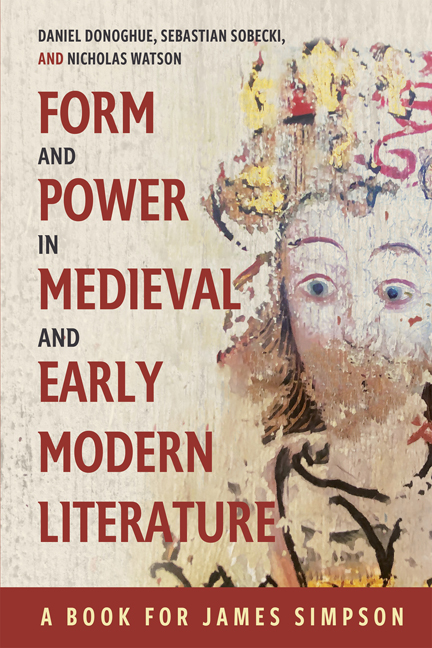Book contents
- Frontmatter
- Contents
- List of Illustrations
- Contributors and Editors
- Acknowledgments
- List of Abbreviations
- Simpson: An Interim Report
- PART I THE HERMENEUTICS OF RECOGNITION
- PART II GENRE AND FIGURE
- PART III CULTURE AND INSTITUTIONS
- PART IV REFORMATIONS
- James Simpson’s Publications from 1984 to 2024
- Bibliography
- A Note on the Bloomfield Conferences
- General Index
- Tabula Gratulatoria
3 - The “Physician’s Tale” and Chaucer’s Art of Prosopopoeia
Published online by Cambridge University Press: 17 May 2024
- Frontmatter
- Contents
- List of Illustrations
- Contributors and Editors
- Acknowledgments
- List of Abbreviations
- Simpson: An Interim Report
- PART I THE HERMENEUTICS OF RECOGNITION
- PART II GENRE AND FIGURE
- PART III CULTURE AND INSTITUTIONS
- PART IV REFORMATIONS
- James Simpson’s Publications from 1984 to 2024
- Bibliography
- A Note on the Bloomfield Conferences
- General Index
- Tabula Gratulatoria
Summary
Geoffrey Chaucer's “Physician's Tale” is a story centrally concerned with the making and unmaking of literary persons. It focuses on the facture and destruction of one figure in particular, that of the maiden Virginia, whose creation is recounted in the opening lines and whose death at her father's hands constitutes the narrative climax. At issue, I suggest, is not only the meaning of her short life but the validity of the rhetorical and narrative techniques that have animated her within the framework of Chaucer's account. The present essay argues that the “Physician's Tale” is fruitfully read as a Chaucerian investigation into prosopopoeia, or the trope of fashioning a mask or face, the poiesis of a prosopon. To borrow a phrase from James Simpson, Virginia's “textual face” is at the center of Chaucer's retelling. Most readers agree that the “Physician's Tale” is not a work that sustains hermeneutic optimism, not in the identification of its genre or moral nor in the parsing of its heroine's fate. Yet it is precisely because the tale is dissonant and self-divided that it makes an apt site for reexamining certain aspects of Chaucer's art.
What do I mean by prosopopoeia? In its broad sense, the figure differs from allegorical personification, or the trope of “lending voice and body to abstract ideas,” as Katharine Breen has recently glossed it. The broader phenomenon (of which allegorical personification would be a particular case) appears in works of classical and medieval rhetorical theory under labels like prosopopoeia, ethopoeia, conformatio, adlocutio, effictio, sermocinatio, ficta oratio, fictio personarum, and personarum ficta inductio. Definitions of these figures emphasize the mercurial interplay of voice, embodiment, presence, and liveliness. The account of conformatio in the Rhetorica ad Herennium is representative, where the figure is explained as “that by which an absent person is represented as though present, or a mute or formless thing is rendered articulate, attributed a definite form and language, or a certain behavior, in conformity with its character.” The definition sets several aspects of personhood in circulation together and would seem to include literary techniques that range from quoting speech to animating formless things, or, in the examples offered by the Ad Herennium author, from giving a city a voice to ventriloquizing the dead.
- Type
- Chapter
- Information
- Form and Power in Medieval and Early Modern LiteratureA Book for James Simpson, pp. 49 - 66Publisher: Boydell & BrewerPrint publication year: 2024



